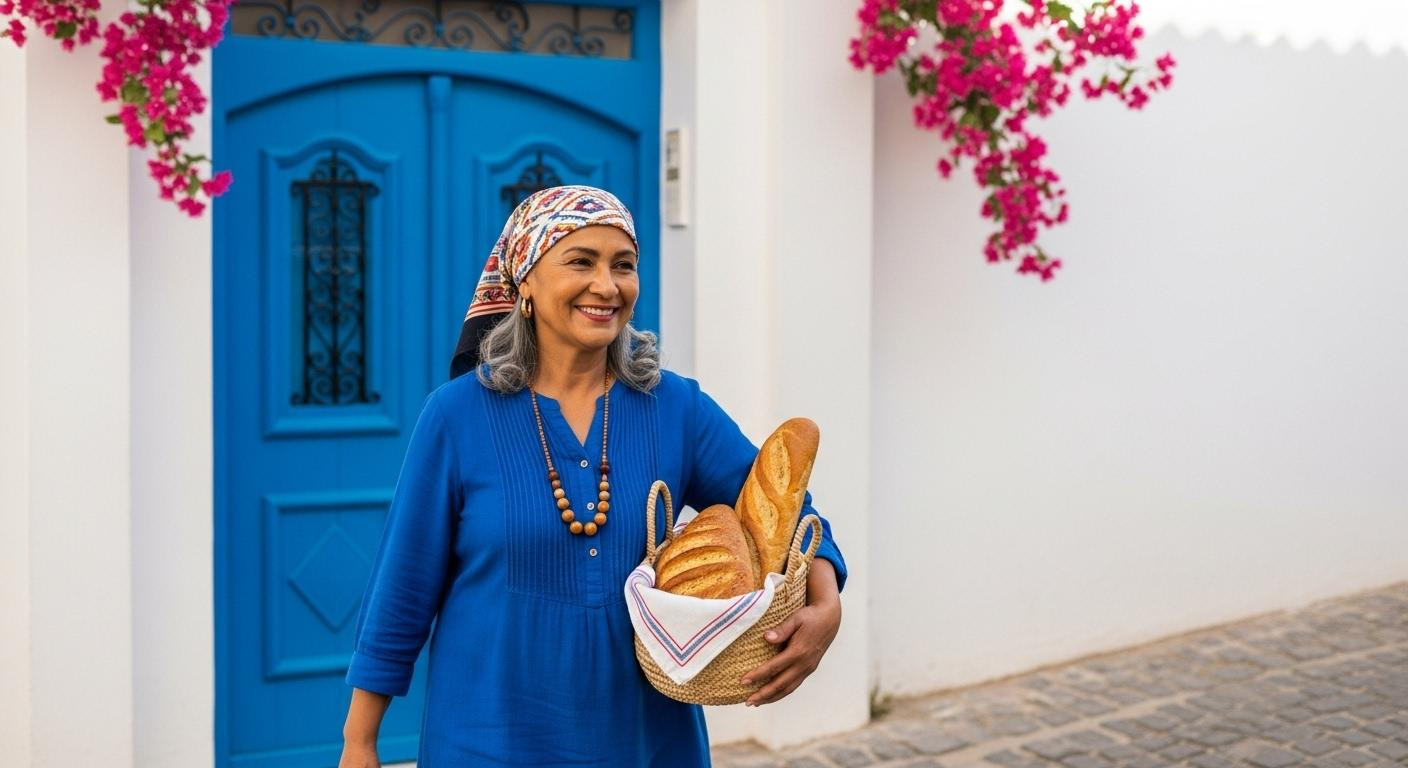Dawn breaks at 6:30 AM over Sidi Bou Saïd’s cobalt-blue doorways as a grandmother walks past carrying fresh bread. No cruise ships queue offshore. No influencers jostle for the perfect angle. While Santorini processes 2 million annual visitors and Cinque Terre charges $300 per night for staged authenticity, this 5,000-resident Tunisian village preserves what Mediterranean coastal towns lost: genuine blue-and-white beauty introduced in the 1910s, $60-120 boutique riads, and 300,000 annual visitors spread across seasons who discover the calm that commercialized destinations sacrificed.
The cliff village where blue doors predate Instagram by 90 years
Perched 492 feet above the Mediterranean Sea, Sidi Bou Saïd sits on limestone cliffs 12 miles northeast of Tunis. The village spans just 0.3 square miles of narrow cobbled streets and whitewashed buildings. Baron Rodolphe d’Erlanger introduced the iconic blue-and-white aesthetic in the 1910s, painting doors, shutters, and ironwork in cobalt blue as a preservation signature.
Tunisia’s tourism industry welcomed 5.3 million visitors by July 2025, up 9.8% from 2024. Yet Sidi Bou Saïd remains remarkably uncrowded compared to Greek islands. Mediterranean alternatives offer similar value without the masses.
The 5,000 residents maintain Andalusian-Arabic architecture featuring flat roofs, intricate stucco, and stone arches. Bougainvillea trails pink against white limestone walls. No resort chains mar the skyline.
Why 5,000 residents keep this Mediterranean secret authentic
Architecture that breathes heritage, not hashtags
Every building follows d’Erlanger’s preservation ordinance from 1910. Whitewashed walls reflect morning light while cobalt blue accents shimmer against turquoise waters. Wrought-iron balconies frame narrow alleys where cats sleep in doorway shadows.
Unlike Santorini’s Instagram-optimized renovations, these structures house actual families. Children play in courtyards their grandparents swept. Local tourism boards confirm that 80% of buildings remain residential homes, not vacation rentals.
Abu Said al-Baji’s 800-year spiritual legacy
The village takes its name from Abu Said al-Baji (1156-1231), a Tunisian religious figure whose shrine anchors the community. Pilgrims have walked these streets for 8 centuries, creating cultural depth that North African coastal destinations preserve better than European tourist magnets.
This spiritual foundation gives Sidi Bou Saïd its unhurried atmosphere. Residents pause for evening prayers as golden light bathes white walls. Tourism feels secondary to daily life.
The spring morning ritual Santorini lost decades ago
Dawn at Café des Nattes without the crowd tax
At 6 AM, Café des Nattes opens its doors to hand-woven mats overlooking the glittering Mediterranean. Mint tea costs $3 versus $15 at Greek tourist cafés. Jasmine and orange blossom scent the morning air as sailboats glide across calm waters.
Recent visitor surveys from 2025 reveal that early morning hours offer the village’s most peaceful experiences. Local innkeepers note that guests who wake at dawn discover Sidi Bou Saïd’s true character before tour groups arrive.
Dar Nejma Ezzahra concerts and brik at local prices
Baron d’Erlanger’s former palace hosts Arab and Mediterranean music concerts for $10-20 per ticket. The venue’s intimate courtyard seats just 200 guests. Authentic local dining follows similar principles of accessibility over exploitation.
Traditional brik (fried pastry with egg) costs $5-8 at family restaurants. Grilled seafood with couscous averages $12-15. The owner of a family café operating since 1947 explains that local pricing keeps the community intact rather than pushing residents out.
The October-November window before crowds become manageable
Spring (March-May) and autumn (September-November) offer optimal timing with temperatures between 65-79°F and fewer visitors. Hotel rates drop to $60-120 per night versus $300+ in Greek islands. The Mediterranean Garden provides shaded contemplation among fragrant plants.
October brings ethereal light quality during golden hours when white walls reflect soft sunlight. Sea salt air carries hints of jasmine while empty cobblestone streets echo only footsteps and distant Mediterranean waves. This sensory calm rewards travelers who choose timing over trending.
Your questions about Sidi Bou Saïd answered
How do I actually get from Tunis airport to Sidi Bou Saïd?
Tunis-Carthage International Airport sits 30-40 minutes from the village by taxi ($10-15) or Metro Leger light rail ($1-2). The Sidi Bou Said metro stop provides convenient access. Spring and autumn timing ensures comfortable exploration without summer heat.
Is the blue-and-white architecture really authentic or tourist-staged?
Baron d’Erlanger established the blue-and-white preservation in the 1910s, decades before mass tourism. Museum exhibits demonstrate how 5,000 residents maintain daily life versus Greek islands’ Instagram-optimized facades. No hotel chains compromise the village’s architectural integrity.
How does it compare cost-wise to Santorini or Cinque Terre?
Accommodation runs $60-120 versus $300+ elsewhere. Meals cost $5-15 versus $25-40 at tourist traps. Museum entry averages $3-5 versus $15-20 at Greek sites. The 10-20% premium over Tunisia’s average still creates 60% savings versus Mediterranean alternatives.
The call to prayer echoes across Sidi Bou Saïd at 5:30 AM while Santorini’s cruise ships sleep offshore. Jasmine trails along limestone walls unchanged since d’Erlanger walked these cobblestones. Blue doors open to residents carrying fresh bread, not influencers staging authenticity they’ll never live.
